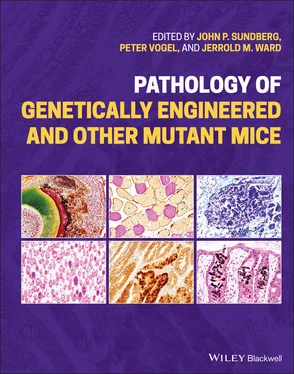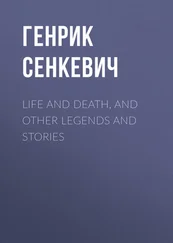Pathology of Genetically Engineered and Other Mutant Mice
Здесь есть возможность читать онлайн «Pathology of Genetically Engineered and Other Mutant Mice» — ознакомительный отрывок электронной книги совершенно бесплатно, а после прочтения отрывка купить полную версию. В некоторых случаях можно слушать аудио, скачать через торрент в формате fb2 и присутствует краткое содержание. Жанр: unrecognised, на английском языке. Описание произведения, (предисловие) а так же отзывы посетителей доступны на портале библиотеки ЛибКат.
- Название:Pathology of Genetically Engineered and Other Mutant Mice
- Автор:
- Жанр:
- Год:неизвестен
- ISBN:нет данных
- Рейтинг книги:3 / 5. Голосов: 1
-
Избранное:Добавить в избранное
- Отзывы:
-
Ваша оценка:
- 60
- 1
- 2
- 3
- 4
- 5
Pathology of Genetically Engineered and Other Mutant Mice: краткое содержание, описание и аннотация
Предлагаем к чтению аннотацию, описание, краткое содержание или предисловие (зависит от того, что написал сам автор книги «Pathology of Genetically Engineered and Other Mutant Mice»). Если вы не нашли необходимую информацию о книге — напишите в комментариях, мы постараемся отыскать её.
An updated and comprehensive reference to pathology in every organ system in genetically modified mice Pathology of Genetically Engineered and Other Mutant Mice
Pathology of Genetically Engineered and Other Mutant Mice
Pathology of Genetically Engineered and Other Mutant Mice — читать онлайн ознакомительный отрывок
Ниже представлен текст книги, разбитый по страницам. Система сохранения места последней прочитанной страницы, позволяет с удобством читать онлайн бесплатно книгу «Pathology of Genetically Engineered and Other Mutant Mice», без необходимости каждый раз заново искать на чём Вы остановились. Поставьте закладку, и сможете в любой момент перейти на страницу, на которой закончили чтение.
Интервал:
Закладка:
61 61 Coan, P.M., Ferguson‐Smith, A.C., and Burton, G.J. (2004). Developmental dynamics of the definitive mouse placenta assessed by stereology. Biol. Reprod. 70 (6): 1806–1813.
62 62 Weninger, W.J. and Geyer, S.H. (2008). Episcopic 3D imaging methods: tools for researching gene function. Curr. Genomics 9 (4): 282–289.
63 63 Ruberte, J., Carretero, A., and Navarro, M. (2017). Morphological Mouse Phenotyping: Anatomy, Histology and Imaging. San Diego, CA: Academic Press (Elsevier).
64 64 Tobita, K., Liu, X., and Lo, C.W. (2010). Imaging modalities to assess structural birth defects in mutant mouse models. Birth Defects Res. C Embryo Today 90 (3): 176–184.
65 65 Cleary, J.O., Modat, M., Norris, F.C. et al. (2011). Magnetic resonance virtual histology for embryos: 3D atlases for automated high‐throughput phenotyping. NeuroImage 54 (2): 769–778.
66 66 Yu, Q., Leatherbury, L., Tian, X., and Lo, C.W. (2008). Cardiovascular assessment of fetal mice by in utero echocardiography. Ultrasound Med. Biol. 34 (5): 741–752.
67 67 Bolon, B., Gabrielson, K., Cole, S. et al. (2015). Three‐dimensional imaging in mouse developmental pathology studies. In: Pathology of the Developing Mouse: A Systematic Approach (ed. B. Bolon), 275–290. Boca Raton, FL: CRC Press (Taylor & Francis).
68 68 Hsu, C.W., Wong, L., Rasmussen, T.L. et al. (2016). Three‐dimensional microCT imaging of mouse development from early post‐implantation to early postnatal stages. Dev. Biol. 419 (2): 229–236.
69 69 Raghunathan, R., Singh, M., Dickinson, M.E., and Larin, K.V. (2016). Optical coherence tomography for embryonic imaging: a review. J. Biomed. Opt. 21 (5): 50902.
70 70 Newbigging, S., Ward, J.M., and Bolon, B. (2015). Necropsy sampling and data collection for studying the anatomy, histology, and pathology of mouse development. In: Pathology of the Developing Mouse: A Systematic Approach (ed. B. Bolon), 133–173. Boca Raton, FL: CRC Press (Taylor & Francis).
71 71 McKerlie, C., Newbigging, S., and Wood, G.A. (2015). Mouse developmental pathology assessments in high‐throughput phenogenomic facilities. In: Pathology of the Developing Mouse: A Systematic Approach (ed. B. Bolon), 377–404. Boca Raton, FL: CRC Press (Taylor & Francis).
72 72 Bolon, B., Duryea, D., and Foley, J.F. (2015). Histotechnological processing of developing mice. In: Pathology of the Developing Mouse: A Systematic Approach (ed. B. Bolon), 195–210. Boca Raton, FL: CRC Press (Taylor & Francis).
73 73 Adissu, H.A., Estabel, J., Sunter, D. et al. (2014). Histopathology reveals correlative and unique phenotypes in a high‐throughput mouse phenotyping screen. Dis. Models Mech. 7 (5): 515–524.
74 74 Kimura, S., Hara, Y., Pineau, T. et al. (1996). The T/ebp null mouse: thyroid‐specific enhancer‐binding protein is essential for the organogenesis of the thyroid, lung, ventral forebrain, and pituitary. Genes Dev. 10 (1): 60–69.
75 75 Min, H., Danilenko, D.M., Scully, S.A. et al. (1998). Fgf‐10 is required for both limb and lung development and exhibits striking functional similarity to Drosophila branchless. Genes Dev. 12 (20): 3156–3161.
76 76 Gibson‐Corley, K.N., Olivier, A.K., and Meyerholz, D.K. (2013). Principles for valid histopathologic scoring in research. Vet. Pathol. 50 (6): 1007–1015.
77 77 Boyd, K.L., Bolon, B., and Bounous, D.I. (2015). Clinical pathology analysis in developing mice. In: Pathology of the Developing Mouse: A Systematic Approach (ed. B. Bolon), 175–193. Boca Raton, FL: CRC Press (Taylor & Francis).
78 78 Dickinson, M.E., Flenniken, A.M., Ji, X. et al. (2016). High‐throughput discovery of novel developmental phenotypes. Nature 537 (7621): 508–514. (Corrigendum: Nature 51 (7680): 398, 2017).
79 79 International Mouse Phenotyping Consortium (IMPC) (2020). Pheno(type) search results: embryo. https://www.mousephenotype.org/data/search?term=embryo&type=pheno(accessed 15 July 2021).
80 80 Palmer, A.K. (1972). Sporadic malformations in laboratory animals and their influence on drug testing. In: Drugs and Fetal Development (eds. M.A. Klingberg, A. Abramovici and J. Chemke), 45–60. New York: Plenum Press.
81 81 The Jackson Laboratory. Mouse phenome database ‐ lethal phenotypes during embryogenesis 2001–2020. http://www.informatics.jax.org/vocab/mp_ontology/MP:0005380(accessed 15 March 2020).
82 82 Shepard, T.H. and Lemire, R.J. (2010). Catalog of Teratogenic Agents, 13e. Baltimore, MD: Johns Hopkins University Press.
83 83 Szaba, F.M., Tighe, M., Kummer, L.W. et al. (2018). Zika virus infection in immunocompetent pregnant mice causes fetal damage and placental pathology in the absence of fetal infection. PLoS Pathog. 14 (4): e1006994.
84 84 Kaufman, M., Nikitin, A.Y., and Sundberg, J.P. (2010). Histologic Basis of Mouse Endocrine System Development: A Comparative Analysis (ed. J.P. Sundberg). Boca Raton, FL: CRC Press (Taylor & Francis Group).
85 85 Baldock, R., Bard, J.B., Davidson, D.R., and Morriss‐Kay, G. (2016). Kaufman's Atlas of Mouse Development Supplement: With Coronal Sections. San Diego, CA: Academic Press (Elsevier).
86 86 Parker, G.A. and Picut, C.A. (2016). Atlas of Histology of the Juvenile Rat. San Diego, CA: Academic Press (Elsevier).
87 87 Papaioannou, V.E. and Behringer, R.R. (2012). Early embryonic lethality in genetically engineered mice: diagnosis and phenotypic analysis. Vet. Pathol. 49 (1): 64–70.
88 88 Wendling, O., Teletin, M., Ghyselinck, N.B., and Mark, M. (2011). Une procédure dédiée au phénotypage de souris porteuses de mutations ciblées, létales in utero ou à la naissance (“A procedure dedicated to the phenotyping of mice carrying targeted mutations, lethal in utero or at birth”) [original in French]. Rev. Fr. Histotechnol. 24 (1): 47–57.
89 89 Bolon, B. and La Perle, K.D.M. (2015). Principles of experimental design for mouse developmental pathology studies. In: Pathology of the Developing Mouse: A Systematic Approach (ed. B. Bolon), 117–132. Boca Raton, FL: CRC Press (Taylor & Francis).
90 90 Diewert, V.M. and Pratt, R.M. (1981). Cortisone‐induced cleft palate in A/J mice: failure of palatal shelf contact. Teratology 24 (2): 149–162.
91 91 Diewert, V.M. (1982). A comparative study of craniofacial growth during secondary palate development in four strains of mice. J. Craniofacial Genet. Dev. Biol. 2 (4): 247–263.
92 92 Hovland, D.N.J., Machado, A.F., Scott, W.J.J., and Collins, M.D. (1999). Differential sensitivity of the SWV and C57BL/6 mouse strains to the teratogenic action of single administrations of cadmium given throughout the period of anterior neuropore closure. Teratology 60 (1): 13–21.
93 93 The Jackson Laboratory. Mouse phenome database ‐ prenatal lethality due to placental pathology 2001–2020. http://www.informatics.jax.org/searches/Phat.cgi?id=MP:0001711(accessed 15 July 2021).
94 94 Bolon, B. and Ward, J.M. (2015). Pathology of the placenta. In: Pathology of the Developing Mouse: A Systematic Approach (ed. B. Bolon), 355–376. Boca Raton, FL: CRC Press (Taylor & Francis).
95 95 Woods, L., Perez‐Garcia, V., and Hemberger, M. (2018). Regulation of placental development and its impact on fetal growth—new insights from mouse models. Front. Endocrinol. 9: 570.
96 96 Bolon, B. (2014). Pathology analysis of the placenta. In: The Guide to Investigations of Mouse Pregnancy (eds. B.A. Croy, A.T. Yamada, F. DeMayo and S.L. Adamson), 175–188. San Diego, CA: Academic Press (Elsevier).
97 97 Bolon, B., Welsch, F., and Morgan, K.T. (1994). Methanol‐induced neural tube defects in mice: pathogenesis during neurulation. Teratology 49 (6): 497–517.
98 98 Tullio, A.N., Accili, D., Ferrans, V.J. et al. (1997). Nonmuscle myosin II‐B is required for normal development of the mouse heart. Proc. Natl. Acad. Sci. U. S. A. 94 (23): 12407–12412.
Читать дальшеИнтервал:
Закладка:
Похожие книги на «Pathology of Genetically Engineered and Other Mutant Mice»
Представляем Вашему вниманию похожие книги на «Pathology of Genetically Engineered and Other Mutant Mice» списком для выбора. Мы отобрали схожую по названию и смыслу литературу в надежде предоставить читателям больше вариантов отыскать новые, интересные, ещё непрочитанные произведения.
Обсуждение, отзывы о книге «Pathology of Genetically Engineered and Other Mutant Mice» и просто собственные мнения читателей. Оставьте ваши комментарии, напишите, что Вы думаете о произведении, его смысле или главных героях. Укажите что конкретно понравилось, а что нет, и почему Вы так считаете.












